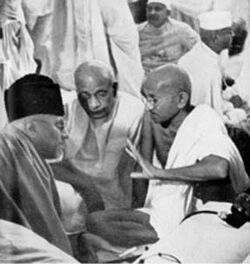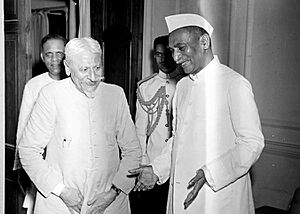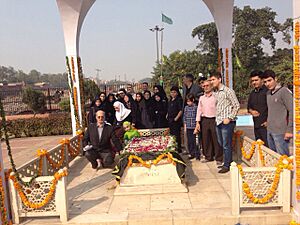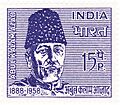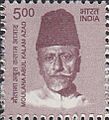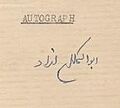Maulana Azad facts for kids
Quick facts for kids
Sayyid
Mawlānā Azad
|
|
|---|---|
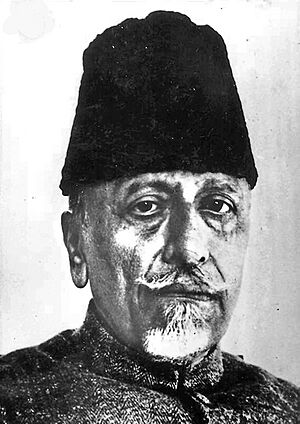 |
|
| 1st Minister of Education | |
| In office 15 August 1947 – 2 February 1958 |
|
| Prime Minister | Jawaharlal Nehru |
| Preceded by | Office Established |
| Succeeded by | K.L. Shrimali |
| Member of Parliament, Lok Sabha | |
| In office 21 February 1952 – 22 February 1958 |
|
| Constituency | Rampur, Uttar Pradesh |
| In office 14 March 1957 – 22 February 1958 |
|
| Constituency | Gurgaon, Punjab (present-day Haryana) |
| Member of the Constituent Assembly of India | |
| In office November 1946 – 26 January 1950 |
|
| Province | United Provinces |
| President of the Indian National Congress | |
| In office 1940–1946 |
|
| Preceded by | Rajendra Prasad |
| Succeeded by | J. B. Kripalani |
| In office 1923–1924 |
|
| Preceded by | Mohammad Ali Jauhar |
| Succeeded by | Mahatma Gandhi |
| Personal details | |
| Born | 11 November 1888 Mecca, Hejaz, Ottoman Empire (present-day Saudi Arabia) |
| Died | 22 February 1958 (aged 69) Delhi, India |
| Cause of death | Stroke |
| Resting place | Jama Masjid, Delhi |
| Political party | Indian National Congress |
| Spouse | Zulaikha Begum |
| Occupation | Theologian, scholar, political activist |
| Awards | Bharat Ratna (posthumously in 1992) |
| Signature |  |
Abul Kalam Ghulam Muhiyuddin Ahmed bin Khairuddin Al-Hussaini Azad (born November 11, 1888 – died February 22, 1958) was an important leader in India's fight for freedom. He was also a writer and a senior member of the Indian National Congress. After India became independent, he became the country's first Minister of Education.
People usually remember him as Maulana Azad. The word "Maulana" means 'Our Master', and he chose "Azad" (meaning 'Free') as his pen name. His birthday is celebrated as National Education Day in India. This day honors his big role in setting up India's education system.
When he was young, Azad wrote poetry in Urdu and books about religion and philosophy. He became well-known as a journalist. He wrote articles that criticized the British Raj (British rule in India) and supported Indian nationalism. Azad led the Khilafat Movement, where he met Mahatma Gandhi. He strongly supported Gandhi's idea of non-violent civil disobedience. He helped organize the Non-Cooperation Movement against unfair British laws. Azad believed in Gandhi's goals, like promoting Indian-made products (Swadeshi) and self-rule (Swaraj) for India. In 1923, at 35, he became the youngest person to be the President of the Indian National Congress.
In 1920, Azad helped start Jamia Millia Islamia, a university that did not take money from the British government. He helped move the university's campus to New Delhi in 1934. One of the main gates of the university is named after him.
Azad was a key organizer of the Dharasana Satyagraha in 1931. He became a major national leader, working for Hindu–Muslim unity and supporting secularism (treating all religions equally). He was President of the Congress from 1940 to 1945. During this time, the Quit India rebellion began. Azad was put in jail with other Congress leaders. He also worked for Hindu–Muslim unity through his newspaper, Al-Hilal.
Contents
Maulana Azad's Early Life and Education
Birth and Family Background
Azad was born on November 11, 1888, in Mecca. At that time, Mecca was part of the Ottoman Empire, which is now Saudi Arabia. His full name was Sayyid Ghulam Muhiyuddin Ahmed bin Khairuddin Al Hussaini. But he became famous as Maulana Abul Kalam Azad.
His family had moved to India from Herat a long time ago. His father was a Muslim scholar who lived in Delhi. During the Indian Rebellion of 1857, his father left India and settled in Mecca. Azad's mother was Sheikha Alia bint Mohammad. Her father was also a respected scholar from Medina. In 1890, Azad's family moved to Calcutta (now Kolkata), India.
Learning and Growing Up
Azad was taught at home and learned a lot by himself. He first learned Arabic fluently. Then he mastered several other languages, including Bengali, Hindustani, Persian, and English. He also studied different Islamic laws, mathematics, philosophy, history, and science with private teachers.
Azad was a very smart and determined student. Before he was 12, he was already running a library and a debating club. At 14, he was writing articles for a literary magazine. By 15, he was teaching a class where most students were twice his age. He finished his traditional studies at 16, much earlier than others. At 13, he married Zulaikha Begum. Azad wrote many books explaining the Qur'an and other religious texts.
Azad's Work as a Journalist
Starting His Writing Career
Azad began working as a journalist when he was very young. At 11, in 1899, he started a poetry journal called Nairang-e-Aalam in Calcutta. By 1900, he was already editing a weekly newspaper called Al-Misbah. He wrote articles for many Urdu magazines and journals.
In 1903, he started a monthly journal, Lissan-us-Sidq. It ran for about two years before it closed due to lack of money. He then joined Al Nadwa, an Islamic journal. He also worked as an editor for Vakil, a newspaper from Amritsar, from 1906 to 1908.
Fighting for India's Freedom
Becoming a Revolutionary
In 1908, Azad traveled to Egypt, Syria, Turkey, and France. There, he met many revolutionaries who wanted change in their own countries. These meetings shaped his political ideas. Azad became a strong Indian nationalist. He openly criticized the British government for its unfair treatment of Indians. He also criticized Muslim politicians who focused only on religious issues instead of common Indian problems.
Azad was against the partition of Bengal in 1905. He became very active in revolutionary groups. He worked secretly to organize meetings and activities in Bengal, Bihar, and Bombay (now Mumbai).
Al-Hilal and the Khilafat Movement
In 1912, he started an Urdu weekly newspaper called Al-Hilal in Calcutta. In this paper, he openly attacked British policies and wrote about the problems faced by ordinary people. He wanted to inspire young Muslims to fight for independence and for unity between Hindus and Muslims.
When World War I started, the British made rules stricter and censored publications. As a result, Azad's Al-Hilal was banned in 1914.
Azad also supported the Khilafat movement. This movement aimed to protect the position of the Sultan of Ottoman Turkey, who was seen as the Caliph (leader) for Muslims worldwide. The Sultan had fought against the British in the war, and his rule was in danger. Azad saw this as a chance to unite Indian Muslims and bring about big political and social changes.
He started a new journal, Al-Balagh, but it was also banned in 1916. Azad was arrested and jailed in Ranchi until 1920.
The Non-Cooperation Movement
When Azad was released, India was full of anger against British rule. The British had passed the Rowlatt Acts in 1919, which took away many civil liberties. Thousands of activists were arrested. The Jallianwala Bagh massacre in April 1919, where unarmed civilians were killed, made Indians even angrier.
Mahatma Gandhi became the leader of the Indian National Congress. He had already led successful protests in Champaran and Kheda. Gandhi developed Satyagraha, a method of mass civil disobedience that was completely non-violent.
Gandhi also supported the Khilafat movement, which helped bring Hindus and Muslims together. Azad and other Muslim leaders welcomed this support. They all worked together on a "non-co-operation" plan. They asked all Indians to boycott British schools, colleges, courts, and public services. They emphasized non-violence and Hindu-Muslim unity. They also encouraged boycotting foreign goods. Azad joined the Congress and became president of the All India Khilafat Committee. Even though Azad and other leaders were soon arrested, millions of people joined peaceful protests.
During this time, Azad' became very close to Gandhi and his ideas. Azad, along with other leaders, founded the Jamia Millia Islamia in Delhi. This was a university run entirely by Indians, without British support. Azad and Gandhi shared a deep interest in religion. Azad adopted a simple lifestyle, like the Islamic prophet Muhammad. He became deeply committed to ahimsa (non-violence). He also became friends with other nationalists like Jawaharlal Nehru and Subhas Chandra Bose.
In 1921, he started another weekly paper, Paigham, which was also banned. He was arrested again and sentenced to one year in prison.
By 1922, both the Khilafat and non-co-operation movements faced problems. There were more acts of violence, like the Chauri Chaura incident where a mob killed policemen. Gandhi, fearing more violence, asked Indians to stop the revolt. This disappointed some leaders. But Azad remained loyal to Gandhi's ideas.
In 1923, Azad became the youngest person to be elected Congress president. He helped organize the Flag Satyagraha in Nagpur. He also worked to unite different groups under the Congress. For years after, Azad traveled across India, promoting Gandhi's vision, education, and social reforms.
A Key Congress Leader
Azad served on the Congress Working Committee and held important positions many times. In 1928, Indians were angry about the Simon Commission, which was set up to suggest changes to the government but had no Indian members. In response, the Congress and other parties formed their own commission to suggest reforms. Azad supported the Nehru Report, which called for an independent India committed to secularism. He also supported ending separate voting groups based on religion.
At the 1928 Congress meeting, Azad supported Gandhi's call for India to become a self-governing dominion within a year. If not, the Congress would demand complete independence. Azad also became friends with young leaders like Jawaharlal Nehru and Subhash Bose. He started to believe that socialism could help fight poverty and inequality in India.
When Gandhi started the Dandi Salt March in 1930, Azad organized and led a non-violent raid on the Dharasana salt works. This was to protest the salt tax. Azad was jailed many times between 1930 and 1934. After the Gandhi–Irwin Pact in 1931, he was released.
When elections were held in 1935, Azad helped organize the Congress election campaign. He raised money, chose candidates, and arranged rallies. He did not run for election himself.
The Quit India Movement
In 1938, Azad tried to bridge differences within the Congress. He stood by Gandhi when most other leaders did. In 1939, he reluctantly supported the Congress leaving the assemblies after India was included in World War II without consulting Indian leaders. Azad criticized Muhammad Ali Jinnah and the Muslim League, who claimed Congress rule was "Hindu Raj."
As the Muslim League gained support for a separate Muslim state (Pakistan), Azad was elected Congress president in 1940. He spoke strongly against Jinnah's Two-Nation Theory, which said Hindus and Muslims were separate nations. Azad argued that all Hindus and Muslims in India were one people, sharing deep bonds. He said:
" Full eleven centuries have passed by since then. Islam has now as great a claim on the soil of India as Hinduism. If Hinduism has been the religion of the people here for several thousands of years, Islam also has been their religion for a thousand years. Just as a Hindu can say with pride that he is an Indian and follows Hinduism, so also we can say with equal pride that we are Indians and follow Islam. I shall enlarge this orbit still further. The Indian Christian is equally entitled to say with pride that he is an Indian and is following a religion of India, namely Christianity."
In 1942, Gandhi and Patel pushed for a full rebellion to demand immediate independence. Azad was unsure, knowing that many Muslims supported the war and looked to Jinnah. He worried that a struggle might divide India. After much debate, Azad became convinced that action was needed.
Supporting the call for the British to "Quit India", Azad began to encourage thousands of people at rallies to prepare for a big struggle. As Congress president, he traveled across India, meeting leaders and planning the rebellion. On August 7, 1942, Azad launched the movement with a powerful speech in Mumbai. Just two days later, the British arrested Azad and all the Congress leaders. Azad and the Congress Working Committee were imprisoned in a fort in Ahmednagar for nearly four years. They were isolated and censored.
During his imprisonment, Azad played bridge and taught Persian, Urdu, and history to his companions. He also started writing his famous Urdu book, Ghubhar-i-Khatir. The leaders avoided political talk to ease the pain of imprisonment. But every year on January 26, they would gather to remember their cause and pray. Azad, Nehru, and Patel would speak briefly about the nation's future.
The Partition of India
After the war, the British agreed to transfer power to India. Political prisoners were released in 1946. Azad led the Congress in elections for the new Constituent Assembly of India, which would write India's constitution. He led the talks with the British Cabinet Mission.
Azad was against Jinnah's demand for Pakistan. He supported the mission's earlier plan for a federal system with a limited central government and autonomy for provinces. This plan also suggested "grouping" provinces by religion. Azad believed this would address Muslim concerns and prevent the demand for Pakistan. With Azad's support, the Congress approved this plan. Azad even got Jinnah to agree to it, hoping for the greater good of all Indian Muslims.
Azad had been Congress president since 1939 and resigned in 1946. He nominated Nehru, who became the new president. Azad was appointed to head the Department of Education. However, Jinnah's Direct Action Day in August 1946 led to widespread violence. Thousands were killed. Azad traveled to Bengal and Bihar to calm tensions and help Hindus and Muslims.
Despite Azad's calls for unity, Jinnah's popularity among Muslims grew. The Muslim League joined a coalition government with the Congress but continued to boycott the constituent assembly. Azad later wrote that Sardar Vallabhbhai Patel became more open to partition because the League refused to cooperate.
Azad was very critical of Jinnah, who called him a "Congress Showboy." Muslim League politicians accused Azad of letting Muslims be controlled by Hindus. But Azad continued to believe in Hindu-Muslim unity:
"I am proud of being an Indian. I am part of the indivisible unity that is Indian nationality. I am indispensable to this noble edifice and without me this splendid structure is incomplete. I am an essential element, which has gone to build India. I can never surrender this claim."
In early 1947, with more violence, the coalition government struggled. The British announced a plan on June 3, 1947, to partition India based on religion. Princely states could choose to join either India or Pakistan. This plan was debated fiercely. Azad discussed it with Gandhi, Patel, and Nehru. Despite his opposition, he could not ignore the League's popularity and the difficulty of working with them. Facing the risk of civil war, Azad did not vote on the resolution, which eventually approved the partition plan.
Azad, who wanted a united India until the very end, was criticized by those who supported Pakistan, especially the Muslim League.
Azad's Role After Independence
India's partition and independence on August 15, 1947, brought terrible violence. Millions of Hindus and Sikhs fled Pakistan to India, and millions of Muslims moved to Pakistan. Azad took responsibility for the safety of Muslims in India. He visited affected areas, helping organize refugee camps and security. He gave speeches, urging peace and encouraging Muslims to stay in India.
He worked to restore peace in Delhi. He organized security and relief efforts. He disagreed with Deputy prime minister Sardar Vallabhbhai Patel over the dismissal of Delhi's police commissioner, who was accused of neglecting Muslim safety. Patel argued that dismissing him would anger Hindus and Sikhs. Azad wanted to ensure Muslims were safe and rehabilitated. He supported equal rights and religious freedom for all Indians.
Azad remained a close advisor to Prime Minister Nehru. He played a big role in shaping national policies. He led the creation of programs to build schools and colleges. He aimed to spread education to all children and young adults. He was elected to the Lok Sabha (the lower house of the Indian Parliament) in 1952. He won again in 1957 from two different areas.
Azad supported Nehru's economic policies and efforts to improve social rights and opportunities for women and underprivileged Indians. In 1956, he was president of the UNESCO General Conference in Delhi. Azad spent his last years writing his book India Wins Freedom, which tells the story of India's freedom struggle. It was published in 1959.
As India's first Minister of Education, he focused on educating poor people in villages and girls. He pushed for adult literacy, free and compulsory primary education for all children up to 14, and vocational training. On January 16, 1948, Maulana Azad said:
We must not for a moment forget, it is a birthright of every individual to receive at least the basic education without which he cannot fully discharge his duties as a citizen.
He oversaw the creation of the Central Institute of Education in Delhi. Under his leadership, the Ministry of Education established the first Indian Institute of Technology in 1951 and the University Grants Commission in 1953. He also focused on developing the Indian Institute of Science, Bangalore and the Faculty of Technology of the Delhi University. He believed the IITs would be very important for India's future.
Azad's Important Writings
Azad wrote many books, including India Wins Freedom, Ghubar-e-Khatir, Tazkirah, and Tarjumanul Quran.
Ghubar-e-Khatir
Ghubar-e-Khatir (meaning Sallies of Mind) is one of Azad's most important works. He wrote it mostly between 1942 and 1946 while he was imprisoned in Ahmednagar Fort by the British.
The book is a collection of 24 letters he wrote to his close friend, Maulana Habibur Rahman Khan Sherwani. These letters were never sent because he was not allowed to send mail from prison. After his release in 1946, he gave the letters to his friend Ajmal Khan, who published them.
Even though it's a collection of letters, most of them discuss deep topics. These include the existence of God, the origins of religions, and the role of music in religion.
The book is mainly in Urdu, but it has over 500 couplets (two-line poems) in Persian and Arabic. This is because Azad grew up in a family where Arabic and Persian were spoken more often than Urdu. He was born in Mecca and learned Persian and Arabic formally, but he was never taught Urdu.
People often say that India Wins Freedom is about his political life, while Ghubar-e-Khatir is about his personal and spiritual life.
Azad's Legacy and Impact
In 1989, the Indian government's Ministry of Minority Affairs created the Maulana Azad Education Foundation. This was done to honor his 100th birthday and to help educate people from less privileged groups. The Ministry also offers the Maulana Abul Kalam Azad National Fellowship to minority students for higher studies like M.Phil. and PhD. In 1992, he was honored with the Bharat Ratna, India's highest civilian award, after his death.
Many institutions in India are named after him. These include the Maulana Azad Medical College in New Delhi, the Maulana Azad National Institute of Technology in Bhopal, and the Maulana Azad National Urdu University in Hyderabad. His home is now the Maulana Azad Museum. National Education Day (India) is celebrated every year on November 11 in India to remember his birthday and his contributions as the first education minister.
He is seen as one of the founders and biggest supporters of Jamia Millia Islamia. Azad's tomb is next to the Jama Masjid in Delhi. People have expressed concern about its maintenance, and in 2005, the Delhi High Court ordered it to be renovated as a national monument. His tomb is a major landmark and attracts many visitors.
Jawaharlal Nehru called him Mir-i-Karawan (the caravan leader), describing him as "a very brave and gallant gentleman." Mahatma Gandhi said Azad was "a person of the calibre of Plato, Aristotle and Pythagorus."
Azad was played by actor Virendra Razdan in the 1982 film, Gandhi. A TV series about him, Maulana Abul Kalam Azad, aired in the 1990s. Another docudrama, Seher Hone Tak, was based on his life. A 2019 film, Woh Jo Tha Ek Massiah Maulana Azad, also told his story.
His birthday, November 11, is celebrated as National Education Day in India.
Commemorative stamps released by India Post (by year) -
Images for kids
See also
 In Spanish: Abul Kalam Azad para niños
In Spanish: Abul Kalam Azad para niños
- Cyrus the Great as Dhul-Qarnayn, a theory first proposed by Azad
- Indian Council for Cultural Relations, international cultural promotion organization founded by Azad



